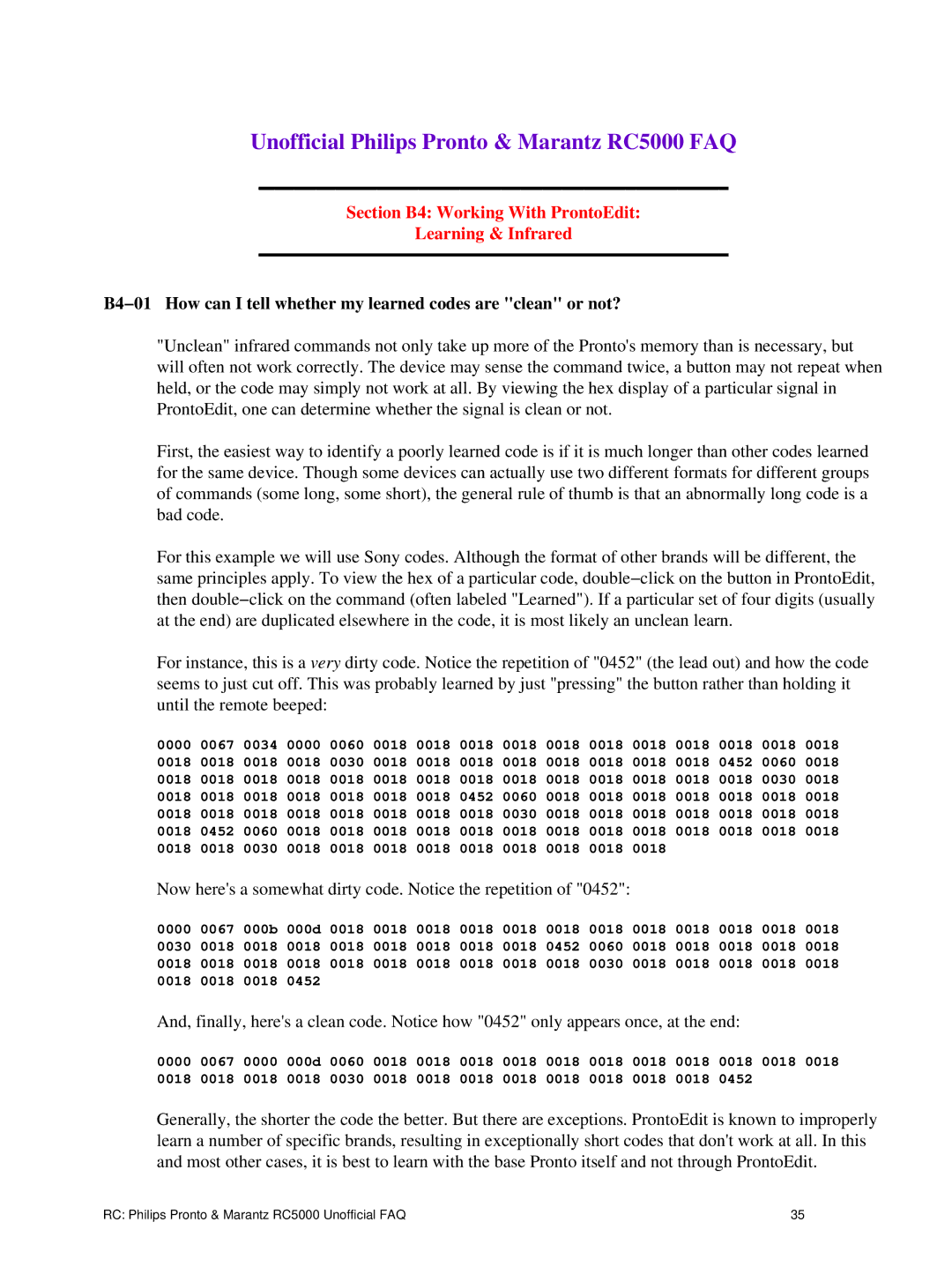
Unofficial Philips Pronto & Marantz RC5000 FAQ
Section B4: Working With ProntoEdit:
Learning & Infrared
B4−01 How can I tell whether my learned codes are "clean" or not?
"Unclean" infrared commands not only take up more of the Pronto's memory than is necessary, but will often not work correctly. The device may sense the command twice, a button may not repeat when held, or the code may simply not work at all. By viewing the hex display of a particular signal in ProntoEdit, one can determine whether the signal is clean or not.
First, the easiest way to identify a poorly learned code is if it is much longer than other codes learned for the same device. Though some devices can actually use two different formats for different groups of commands (some long, some short), the general rule of thumb is that an abnormally long code is a bad code.
For this example we will use Sony codes. Although the format of other brands will be different, the same principles apply. To view the hex of a particular code, double−click on the button in ProntoEdit, then double−click on the command (often labeled "Learned"). If a particular set of four digits (usually at the end) are duplicated elsewhere in the code, it is most likely an unclean learn.
For instance, this is a very dirty code. Notice the repetition of "0452" (the lead out) and how the code seems to just cut off. This was probably learned by just "pressing" the button rather than holding it until the remote beeped:
0000 0067 0034 0000 0060 0018 0018 0018 0018 0018 0018 0018 0018 0018 0018 0018
0018 0018 0018 0018 0030 0018 0018 0018 0018 0018 0018 0018 0018 0452 0060 0018
0018 0018 0018 0018 0018 0018 0018 0018 0018 0018 0018 0018 0018 0018 0030 0018
0018 0018 0018 0018 0018 0018 0018 0452 0060 0018 0018 0018 0018 0018 0018 0018
0018 0018 0018 0018 0018 0018 0018 0018 0030 0018 0018 0018 0018 0018 0018 0018
0018 0452 0060 0018 0018 0018 0018 0018 0018 0018 0018 0018 0018 0018 0018 0018
0018 0018 0030 0018 0018 0018 0018 0018 0018 0018 0018 0018
Now here's a somewhat dirty code. Notice the repetition of "0452":
0000 0067 000b 000d 0018 0018 0018 0018 0018 0018 0018 0018 0018 0018 0018 0018
0030 0018 0018 0018 0018 0018 0018 0018 0018 0452 0060 0018 0018 0018 0018 0018
0018 0018 0018 0018 0018 0018 0018 0018 0018 0018 0030 0018 0018 0018 0018 0018
0018 0018 0018 0452
And, finally, here's a clean code. Notice how "0452" only appears once, at the end:
0000 0067 0000 000d 0060 0018 0018 0018 0018 0018 0018 0018 0018 0018 0018 0018
0018 0018 0018 0018 0030 0018 0018 0018 0018 0018 0018 0018 0018 0452
Generally, the shorter the code the better. But there are exceptions. ProntoEdit is known to improperly learn a number of specific brands, resulting in exceptionally short codes that don't work at all. In this and most other cases, it is best to learn with the base Pronto itself and not through ProntoEdit.
RC: Philips Pronto & Marantz RC5000 Unofficial FAQ | 35 |
